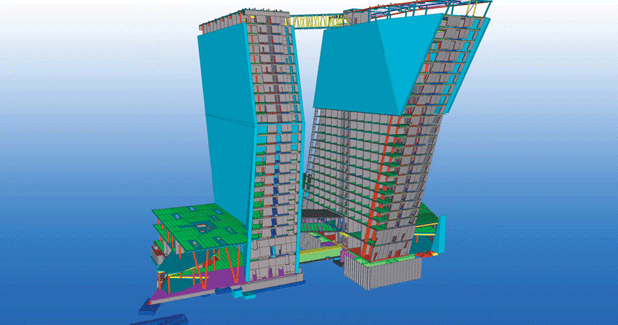While 3D precast technology has many benefits, its successors, 4D and 5D, offer even more.
3D technology is a common aspect in the Indian construction industry. The 3D BIM models are perfect for visualising how a project will look, how it fits into the current landscape and perhaps even offer a walkthrough to show how visitors will interact with the building. Indeed, 3D precast technology has many benefits. However, 4D can certainly provide higher benefits compared to other technologies similar to BIM. Pioneers in construction scheduling assert that 4D BIM should be both sequencing and scheduling, plus in fabrication or on-site production control. ¨Eventually 4D BIM integrates quantity takeoff, location-based quantities, resources, productivity rate, and labour costs into BIM and it becomes 5D BIM (where BIM tools are effectively used through fabrication and construction: BIM authoring and process management software),¨ says Thorsten Hertel, Product Manager, Precast Segment, Tekla Corporation.
He adds that construction sequencing and planning can also produce 4D animation. This means elements from the model are assigned a logical construction sequence and put together in an animation that shows the owner how the building will come together. Hertel shares the benefits of this technique exclusively with CW.
Precast segment
The precast sector can gain a huge amount of information from the technology and 4D precast technology provides the right information required for the construction of any structure. It gives real-value information from the work done in the precast sector.
Effectiveness should not only be measured by short gains in direct productivity (which, by the way, are huge too), but with several benefits that robust information management can deliver - for the process and organisation. BIM technology enables processes to avoid double and overlapping work as information is added along the process and can be used directly in formats needed by different stakeholders.
Varied application
In a huge country like India, there is huge demand from infrastructure projects like bridges, commercial buildings, hospitals and real-estate, etc. The technology has no limitation from a software point of view; any kind of projects can be done with it, with many benefits for projects where models are used through the value chain, from engineering to fabrication and construction. We have customers who have made civil and infrastructure projects, like bridges, highway ducts, hospitals and parking facilities, as well as commercial and residential development, at any scale stating from housing to huge stadiums and shopping malls.
Software process
In precast construction projects, software is often used extensively through the sales-design-detailing-fabrication stages. It provides robust process tools for users who are modelling, detailing, organising, sharing and extracting construction information like quantity takeoffs, construction simulation, engineering of alternative solutions, drawings and reports creation, production planning or sharing model information such as statuses. The software uses a detailed application process that stores the necessary information and is processed into the detailing required. It also provides a fluent two-way highway to communicate with other software solutions used in the industry.
Benefits galore
The original BIM 3D model provides many aspects that prevent production errors. We are going to reduce waste through this technology. It certainly will reduce consumption cost and decrease the labour cost involved. BIM information is always created from the model, including drawings, reports and other outputs, which prevents users from making mistakes in the documentation stage. Construction waste is a global issue. By means of error-free models that provide model-based quantities and model tools to link information to actual products, there is a way to work towards preventing construction waste.
In comparison
Clearly, 3D and 4D BIM should be used hand in hand; the 3D model that contains all construction materials and objects should be connected to 4D (time and sequence) and even 5D (quantity and cost). In other words, 3D provides design and fabrication data and information, and 4D provides process information where time and sequence are included. When it comes to 5D, quantities and costs are linked to the model.
The technology investment is justified through the benefits that come from better processes, quality and waste reduction. BIM-based information and workflow tools are the right path; people will learn and adopt skills - if not present already û as the process of generating and managing building data is not new to the construction industry. The new technology streamlines and optimises the processes of the construction industry, but does not necessarily change them.
In fact, it can change the way we build. The benefits you gain from this are savings in the cost of materials and labour used, which automatically subsidise the investment you have made in the technology.
Based on limited experiences from India, I feel people are keen to adapt new technologies on individual levels. India is also known to be a well-informed IT society that has created companies with the vision to adapt new technology and take technology leaps.
Awareness in India
In India, 3D BIM technology is already popular. The upgraded 4D version visualises the information stored through the 3D model. In many cases, 4D adds critical information to a complex project. For example, by utilising simulation and connecting virtual assemblies or elements to production or construction flow, it helps the organisation optimise and visualise the process for best possible output. Document-based management can be a nightmare, especially in large and complex projects. We have actually advocated that engineers, fabricators and contractors search for optimisation of the whole value chain (total process optimisation) instead of focusing on task-based optimisation, like producing drawings, where benefits in project and fabrication scale remain small.




















